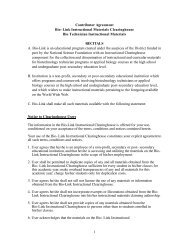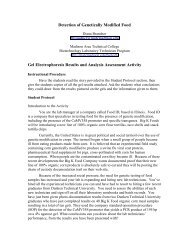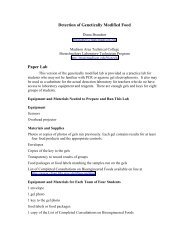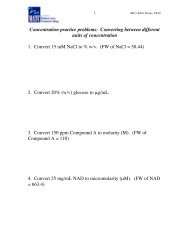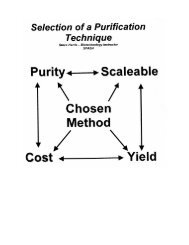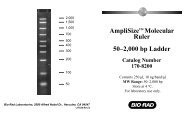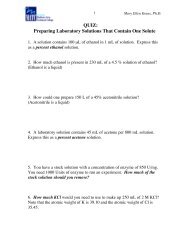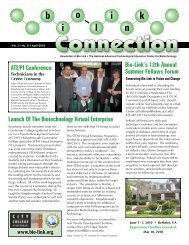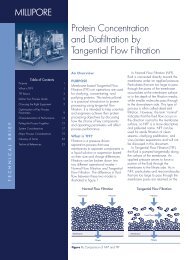STARCH HYDROLYSIS The cornstarch separated from ... - Bio-Link
STARCH HYDROLYSIS The cornstarch separated from ... - Bio-Link
STARCH HYDROLYSIS The cornstarch separated from ... - Bio-Link
Create successful ePaper yourself
Turn your PDF publications into a flip-book with our unique Google optimized e-Paper software.
<strong>STARCH</strong> <strong>HYDROLYSIS</strong><strong>The</strong> <strong>cornstarch</strong> <strong>separated</strong> <strong>from</strong> the kernel by the wet milling process is generally 99% pure and contains0.25-0.35% protein, 0.5-0.6% lipid and less than 0.1% minerals. 35% of the industrially prepared<strong>cornstarch</strong> is utilized by the food industry; the remainder of the starch is further refined or modified for usein the paper and construction industries. A significant proportion of the <strong>cornstarch</strong> derived <strong>from</strong> the wet-milledprocess used for food goes into the fermentation of beer. To be useful to the breweries, it first has tobe converted into dextrose or d-glucose. This is an example of down-stream processing; a raw material isisolated and used as a starting material in another process.<strong>STARCH</strong> FOUND IN CORNCornstarch is found in granules within the kernel as a long polymer composed of two structural classes:amylose and amylopectin. <strong>The</strong> basic repeating unit for both types of starch is d-glucose molecules,connected by glycosidic bonds. <strong>The</strong> polymer chains and the formation of the intermolecular network trapswater and results in gel formation and solution thickening. After the starch is completely hydrolyzed orbroken down its basic component is d-glucose also called dextrose or corn sugar.MOLECULAR STRUCTURE OF <strong>STARCH</strong>Amylose is a linear polymer of short 1,4 linked glucose chains. Typically the amylose fraction is about 25-30%of the starch molecules found in corn and has a molecular weight of about 250,000. <strong>The</strong> percentage ofamylose in the starch is genetically determined. Genetic modifications producing high-amylose (50-70%)<strong>cornstarch</strong> are also found. Amylopectin comprises about 70-75% of the starch found in the corn kernel andhas a molecular weight of about 50-500 million. Amylopectin is a branched polymer of the basic repeatingunits of 1,4 linked glucose with branches of 1,6 linked glucose. <strong>The</strong> branching occurs irregularly in thestarch, approximately one per twenty-five glucose units.AmyloseAmylopectinAMYLASESAmylases are a class of enzymes that are capable of digesting these glycosidic linkages found in starches.Amylases can be derived <strong>from</strong> a variety of sources. Amylases are present in all living organisms, but theenzymes vary in activity, specificity and requirements <strong>from</strong> species to species and even <strong>from</strong> tissue totissue in the same organism. Alpha-amylase (1,4 aD-Glucan-glucanohydrolase) acts upon large polymersof starch at internal bonds and cleaves them to short glucose polymers. a-amylase catalyzes the hydrolysisof internal a1-4 glucan bonds in polysaccharides containing 3 or more a1-4 linkages; it results in a mixtureof maltose and glucose. Amyloglucosidase works on the shorter polymers and splits off single glucosesugars. Bacterial a-amylase is particularly suited for industrial usage since it is inexpensive and isthermally stable.
ASSAY OF THE AMOUNT OF <strong>STARCH</strong> IN CORN FRACTIONSIt may be desirable to determine the amount of starch in each fraction of the corn kernel to determine theefficiency of the fractionation process and to determine the suitability of the particular batch of corn or thegenetic makeup of the particular corn strain. <strong>The</strong>refore a simple assay for the presence and amount ofstarch is possible. <strong>The</strong> assay that is used is based on the hydrolysis of the starch by the above enzymes.<strong>The</strong> final product of the hydrolysis, glucose, is then determined by the glucose oxidase assay.DETERMINATION OF THE AMOUNT OF GLUCOSE PRESENTGlucose is determined by an enzymatic reaction. <strong>The</strong> enzyme glucose oxidase converts glucose to gluconicacid and hydrogen peroxide in equal molar amounts. <strong>The</strong> amount of glucose is then determined by thereaction of the peroxide with the chromophore, aminoantipyrine, to produce a color change that is detectedat 505nm.SYNOPSISSample is prepared and primary digestion with a-amylaseSecondary digestion with amyloglugosidase results primarily in glucoseGlucose is digested with Glucose oxidase to gluconic acid and hydrogen peroxideHydrogen peroxide is changed to an active form by hydrogen peroxidase<strong>The</strong> product of the peroxidase reaction complexes with the chromophore, aminoantipyrineColor change is followed by change in absorbance at 505nmSAFETYRead the MSDS information for all chemicals used in this exercise. Phenol and aminoantipyrine areconsidered harmful or hazardous materials, use gloves when using these compounds. Wear lab coat andproper eyewear.MATERIALS<strong>cornstarch</strong> (<strong>from</strong> commercial source or use the <strong>cornstarch</strong> isolated <strong>from</strong> Corn Wet Milling Lab)bacterial a-amylase (Sigma A-3403)amyloglucosidase (Boehringer Mann 846)glucose oxidase (Sigma G-6500)anhydrous glucose (Sigma G-5000)Glucose oxidase-Peroxidase reagent (GOP)Na2HPO4-12H2O 11.5gKH2PO4 2.5gPhenol 500mg4-aminoantipyrine 75mg (Sigma A4382)Peroxidase 3500UGlucose oxidase 3500UDissolve in water and make up to 500mL. pH the solution to 7.0 and filter through a glassmicrofiber filter (Whatman GF/A)Store at 4 ° protected <strong>from</strong> light and use within one monthAmyloglucosidase (AMG) 2mg/mLAmyloglucosidase 30mgdissolve in 15mL of AMG bufferAMG Buffer(pH 4.6)Citric Acid monohydrate 460mgSodium citrate dihydrate 840mgDissolve in 100mL water check pH to 4.6
Use tightly stoppered screw capped tubes.Place tube in a water bath 35° for 45 minutes, keep protected <strong>from</strong> the light.Cool to room temperature for 10 minutes in the dark.Measure the absorbance in 1-cm cells at 505 nm against the water blank.Read absorbance within 30 minutes.Subtract the a-amylase reading <strong>from</strong> the sample reading.Determine the amount of glucose in the samples by comparing them to the standard curve.Multiply the amount of glucose in the samples by 0.9 to give an indication of the amount of starch in thesamples. This is an adjustment <strong>from</strong> free glucose to anhydro glucose as occurs in starch.REFERENCESKarkalas, John, An improved enzymatic Method for the Determination of Native and Modified Starch, JSci. Food Agric., 36, 1019, 1985.Amer. Assoc. Cereal Chem. Approved Methods, 9th ed. Method 76-12, 1995.





